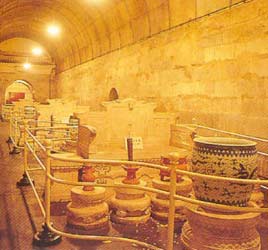
The 13 imperial tombs of the Ming Dynasty (1368-1644), or Shisanling, (literally the 13 Tombs) was awarded the certificate of world culture heritage by UNESCO recently, six months after it was officially inscribed into the World Heritage List.
As one of the most popular travel destinations in Beijing, the Ming Tombs is the sixth Beijing attraction to be inscribed into the list. The other five are The Great Wall, the Imperial Palace of the Ming and Qing Dynasties (The Forbidden City), the Peking Man Site at Zhoukoudian, the Summer Palace and the Temple of Heaven.
Years of renovation work on the tombs helped China secure the listing, making the ancient mausoleums more attractive and convenient for travel.
Covering a huge area, the Ming Tombs are located 40 kilometres northwest of downtown Beijing.
It is a good place to visit if you are interested in dynastic history.
Spring is the best time of year to visit, when the area surrounding the vaults is alive with trees and blooming flowers.
The Ming Tombs lie in a broad valley to the south of Tianshou (Longevity of Heaven) Mountain in Changping District. To the southwest of this valley, a branch of the Yanshan Range suddenly breaks off and forms a natural gateway to the 40-square-kilometre basin in which the tombs were built.
The tomb area begins with an impressive marble archway, erected in 1540, with its delicate relief carvings of lions, dragons and lotuses.
About one kilometre to the northeast of this archway stands the Great Red Gate (Dahongmen), the outermost gate of the entire necropolis.
The Great Red Gate marks the beginning of the 7-kilometre-long Sacred Way (Shendao), which leads to the entrance of Changling, the tomb of Emperor Yongle (reign 1403-1424).
Continuing on, you come to a tall square stela pavilion, with four white stone ornamental columns (huabiao) set at each of its four corners, standing boldly in the centre of the Sacred Way.
There are 24 stone creatures in all. These beasts are followed in turn by a group of 12 stone human figures, which represent the funeral cortege of the deceased emperors.
Immediately beyond these human figures are the Dragon and Phoenix Gate (Longfengmen), which are pierced with three archways.
Continuing north to the Changling, the Sacred Way passes over a river via two bridges of five and seven arches respectively.
From here, all 13 tombs can be seen. The foothills and groves of trees dotted with golden yellow roofs stretch for 19 kilometers across this sacred valley.
Only three of the tombs are actually open for viewing. Changling, the earliest and largest of the tombs, dates from the year 1413. Another, Dingling, was constructed in the 16th century for the emperor Wanli, who gave a party in his own funeral chamber to mark its completion. The tomb was excavated in 1958 and treasures found inside are now on display in a hall nearby. Zhaoling is the tomb of the 12th Ming emperor Muzhong and his three concubines. But few people visit it.
In addition to these, there are several more tombs which are unreconstructed. The area makes for a nice day trip from the city.
Explore the old tombs and picnic at a nice spot. Nearby is the Shisanling Reservoir, which itself is also a attractive spot.
Some golf courses, picnic areas, swimming pools, hotels, summer resorts and various restaurants and cafes have been built around the Ming Tombs over the past few years.
For those who want a two-day trip here but don't want to be restricted in a hotel or mountain villa, camping in the mountains around the Shisanling Reservoir is one possibility.
The reservoir is a popular site for camping in spring.
Fires are absolutely forbidden in the mountains which are covered by forests.
Entrance for Changling: 45 yuan (US$5.4), Dingling: 60 yuan (US$7), Zhaoling: 30 yuan (US$4), Shenlu: 30 yuan (US$4).
Getting there: Taking a one-day tourist bus is a good option. Tourist bus numbers 1, 2, 3, 4, 5, which can be boarded at Qianmen, Hepingjie Beikou, Dongzhimen and some other places, all get you there (though they don't visit Zhaoling.) Another option is to take the bus to Changping District, then transfer to a small bus to travel the rest of the way. You can also take a taxi from Changping for going onward. The fare is about 10 yuan (US$1.2). If you drive yourself, take the Badaling Highway from Madian, then follow the signs to Changping.
Telephone contacts:
Dingling: 86-10-60761424
Changling: 86-10-60761334
Zhaoling: 86-10-60761435
Shenlu: 86-10-89749383.
(Beijing Weekend April 23, 2004)
|

